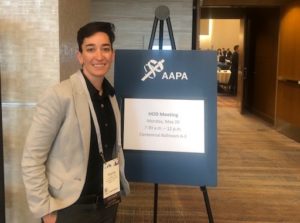An Incubator for Leadership, USACS Hatches Second SEMPA President in Four Years

US Acute Care Solutions employs a large portion of Emergency Medicine PA workforce, says Dayna Jaynstein – likely significantly more than its fair share relative to other acute care groups. The group’s Physician to APP ratio is almost exactly 2:1. So perhaps it’s not surprising that Jaynstein makes the second SEMPA president to come out of USACS in the last four years.
Jaynstein, who works at several USACS sites in Denver, assumed the SEMPA presidency in April. USACS Vice President and National Director of APPs Krisi Gindlesperger served as SEMPA president in 2016 and 2017.
“USACS has a huge share of the EMPA workforce,” Jaynstein said in a recent interview. “By sheer numbers the possibility is just high [that the SEMPA president will be from USACS] because we employ so many.”
Another factor, according to Jaynstein, has to do with being a national group that is still capable of maintaining a close-knit culture across regions.
“I think we’ve had good internal connections with USACS,” she said. “Had I just worked for my independent EM practice, the possibility of knowing Krisi and these other people across the country would never have existed. That opens up a whole new level of opportunities to do things that you’ve never heard about.”
Jaynstein has been a PA for more than a decade. She has also been involved in education and teaching at Denver’s Red Rocks PA program since 2013. She started her career with USACS founding partner EPPH (Emergency Physicians at Porter Hospitals) in 2009, but she left that group to work at another site in Denver, then came back to USACS two years ago. She said her decision to come back had a lot to do with the commitment to APP leadership that Gindlesperger put in place.
“The fact that she created these leadership positions and filled them with my peers was very important to me,” Jaynstein said. “USACS does APP leadership training and a whole bunch of additional things I had never heard of as opportunities.”
In other community hospital settings, Jaynstein said, it’s rare for APPs to be in leadership roles, and often have to fight just to have a say in clinical practice decisions.
Yet moving beyond simply being excellent clinicians is key to the future of her profession, Jaynstein said. One of her top priorities as SEMPA president is creating even more leadership opportunities for more PAs, so that they can gain experience contributing to healthcare beyond just clinical practice.
“We’ve been very good as clinicians, but in order for the profession to move forward you need to contribute in other realms,” she said. Realms such as research, student development and education, leadership, and advocacy. As SEMPA president, Jaynstein said she will also work to continue the development of a PA mentorship program, pairing experienced PAs with newer ones around the country. And, she said, continuing to work closely with their emergency medicine physician colleagues, is critical to offering patients the best care possible.

